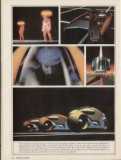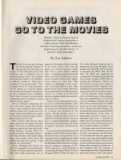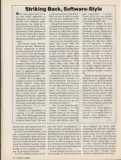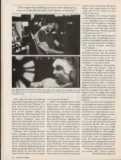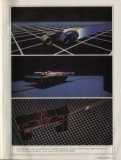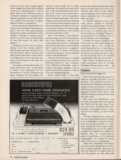With Starblasters already a coming attraction, some are beginning to call this trend, "A perfect, ideal marriage"
Timothy Ferris has been losing a lot of time playing Tempest. "I was playing it the other day," he recalls. "It was a beautiful day in San Francisco and I wandered into an arcade along the wharf. As I pumped more and more quarters into Tempest. I suddenly wondered. 'What am I doing here? It's a gorgeous day." " Ferris laughs before arriving at his point. "Video games are computer games. Every area that computers have touched, they (computers) have infiltrated. That's what you get for setting loose a competing form of intelligence on the surface of your planet."
Steven Lisberger's allegiances are torn. The video games that he likes from a visual standpoint don't always hold up in other ways. Right now, Lisberger rallies behind Battlezone, primarily because he likes the game's three-dimensional point of view.
What interests Bill Kroyer about video games are the people who play them. "Of course, everybody has their own story about why they take up different hobbies," he says. "But I see trends in certain video game players – how their families think about them, what other people think about the people who play video games. I find that all very interesting."
Ferris, Lisberger and Kroyer are part of a vanguard of young filmmakers who are using computer animation and other high technology arts to transport video games from the arcade to the silver screen. Now that the games have proven beyond a doubt they have a solid audience behind them— arcade games grossed about $6 billion last year with Pac-Man equaling the income of Hollywood's biggest money-maker ever, Star Wars— film studios are beginning to take notice. The prevailing wisdom is that video games can serve as a timely vehicle for steering characters into high-speed adventure or, at least, as an electronic backdrop against which personal dramas can unfold.
Disney's Tron. which opened in July, promises to be the first of many video game fantasies that will be played out on the big screen. Written and directed by Lisberger and produced by his partner Donald Rusher, Tron is a cinematic landmark, the First movie to combine live-action with the extensive use of computer-generated imagery. Essentially, the story is about life inside a computer and goes something like this:
An arcade owner named Flynn (Jeff Bridges), author of the hit game Space Paranoids and ex-programmer for a communications conglomerate called ENCOM. suspects ENCOM executive Ed Dillinger (David Warner) of pirating the computer programs of ENCOM employees, a deed Dillinger is committing through a Master Control Program (MCP). With the help of a Dr. Gibbs (Barnard Hughes) and his assistant Lori (Cindy Morgan). Flynn sneaks into ENCOM, where he plans to decipher the MCP. But, by this time, the MCP has outgrown the commands of Dillinger and is patching into systems outside of ENCOM, including the Pentagon's. Before our hero is able to uncover any evidence of wrongdoing, the MCP "digitizes" him, sending him reeling into the film's electronic realm. Flynn never has a chance.
In this alternate world, programs exist as the alter-egos of the programmers who created them. It is a world ruled by Dillinger's wicked alter-ego Sark, who sentences Flynn to a death match on his own video game creations. Along with Alan Bradley who doubles as the security program TRON (Bruce Boxleitner), Flynn duels on game grids, narrowly escapes on an electronic light cycle, is pursued by tanks, travels on a solar sailer and goes to battle on a Sea of Simulation in an all-out effort to destroy the MCP.
Lisberger came up with the idea for Tron in 1977 after completing a round of home video games with his family. "I was impressed with the games because, to me, they represented a bridge to technology," he says. "They're artistic and oriented towards more human things than computers usually are. I was intrigued with the concept of expanding upon that, using computer-generated visuals to take video games beyond their conventional look to a more intense, more realistic look."
For the 31 -year-old filmmaker, Tron was a natural step in an ambitious career in animation. While still at the School of the Boston Museum of Fine Arts, his "Cosmic Cartoon" was nominated for a Student Academy Award in 1973. He first worked professionally at PBS on such programs as "Nova" and "An Evening at the Pops."
In 1976, Lisberger created a six-minute film titled "Animalympics," in which animals performed in various Olympic sports. The idea landed him a $10,000 grant from the American Film Institute, and the project grew into a 90-minute, multi-million dollar production. In order to complete the project, Lisberger moved to larger studios in Venice, California and brought with him the treatment for Tron.
It took Lisberger two years to write the screenplay as well as research the latest computer and optical effects technology. By mid-1980, after negotiating with several other studios, he struck a deal with Walt Disney Productions. "It seemed like a natural choice," explains Lisberger, "because Disney's always talking about trying to make technical breakthroughs. Also, since I knew there was going to be a lot of computer-generated animation in the film, I thought Disney would be a logical place to do that."
Now came the task of assembling the project's creative braintrust. French comic-strip artist Jean "Moebius" Giraud. one of the founders of Heavy Metal, was flown in from France to work on the character styling and storyboarding. Industrial designer Syd Mead was chosen to render the vehicles (police recognizers, tanks and lightcycles) that would later be computer-generated. High-tech artist Peter Lloyd was asked to contribute color styling and background design.
Lisberger also recruited Richard Taylor, manager of the Movie Technology Division of Information International, Inc. (Triple-I) and winner of four Clio awards for excellence in television commercial production, to oversee computer imaging and optical effects along with Harrison Ellensaw, matte painter for Star Wars and The Empire Strikes Back, who also signed on as associate producer.
Finally, four leading computer graphics houses — Triple-I, Mathematics Applications Group, Inc. (MAGI), Digital Effects, Inc. and Robert Abel and Associates — were hired to execute the computer images that were to be choreographed by animators Jerry Rees and Bill Kroyer. Matched with the live-action, these computer-generated scenes would create what Lisberger now calls "counterfeit reality."
As an animator schooled in the classic tradition (he worked on Disney's Pete 's Dragon. The Fox and the Hound and with Lisberger on Animalympics), Bill Kroyer found Tron unusually challenging, the artistic payoff especially rewarding. "For example, when we had two motorcycles racing across a grid," Kroyer comments, "we would have to tell (the programmers) where they would turn, how they would bank and how they would skid. We had to define every single motion of every single axis of every object for every frame of the scene.
"In addition," he continues, "we had to define to the programmers, and they to the computers, where the camera would be, how it would move throughout the scene, what angle we'd be shooting at, where the light sources would be and what the choreography of the scene would be."
Armed only with their animation experience and sketchbooks, Kroyer and Rees immediately had to come to terms with a process entirely foreign to them. Kroyer, it seems, came away overwhelmed.
"I don't think there's ever been a filmmaking process that has allowed an artist to transfer his personal vision onto the screen as intact as we experienced with this computer image choreography. It was quite a thrill.
"A live-action director," Kroyer adds, "has actors who interpret what he wants, has set designers, cameramen and lighting men, editors and a number of people who put their two cents in. An animator has to contend with his own drawing ability, with his director and photographers. But, a computer image choreographer goes one-step. He goes from his mind to the computer and the computer goes right to the negative film. The images that ended up on Tron were identical to what we originally thought— with practically no dilution."
As excited as he is about these latest technological developments. Kroyer is quick to point out that computer choregraphy should only be another tool in the filmmakers' repertoire and not a substitute for either classical animation or live-action performances.
"You just can't do organic characters the way you can with hand-drawn animation," he says. "But, you can do a lot of the busy work, a lot of the mundane processes of character animation with computers. Plus, computers replace model photography and a lot of other types of special effects work. The important thing is that in animating with computers you can do a whole realm of brand new artwork that was not available to us before."
"There's going to be a meeting of the two worlds soon," Kroyer predicts.
"As artists learn a little more about the machinery, and the machinery gets so simple that you can eliminate the middleman — the programmer— artists will start sitting down at the computer terminal and creating films directly."
It shouldn't come as a great surprise that during the production of Tron. the cast and crew became hopelessly hooked on video games. Whenever taking time off from the rigors of creating or acting out roles in the forbidding world inside the computer, they were playing actual games that were installed off-set. Kroyer's interest in the psychology of video game players as well as new and different computer image techniques intensified so rapidly that even before post-production on Tron was completed, he had turned in a first-draft screenplay for Spaceblasters, a second video game-oriented flick, to Polygram and CBS Theatrical. Both companies agreed to buy a piece of the action.
Like Tron, Spaceblasters will combine live-action with computer-generated images and other special effects techniques, including lasers. Current plans call for four different styles of computer animation to earmark four separate sequences in the film. However, unlike Tron. the heart of Spaceblasters will be its characters.
Says co-producer Adam Fields: "It's the story of four typical American teenagers, who are video game fanatics despite the wishes and desires of their families. Through a certain circumstance of events, they are called upon to save the world. It's every kid's fantasy."
Among the first to join the Spaceblasters crew was "science advisor" and Tempest devotee Timothy Ferris. An astronomer, author (Galaxies and Red Limit) and former science editor at Rolling Stone, Ferris has been giving a lot of thought to the film's sets and designs.
"To make an advanced set that, in a sense, really does work — or that thinks it works— is an approach I'm very interested in." he says. "I'd like to get more integrity into the design. For instance, when people try to make spaceships, the reason they most often fail is that the spaceship doesn't actually work. I know that sounds like a silly thing to say — you're not going to build an actual spaceship — but if you design a set from ground up, meaning you sit down with an engineer and justify everything you've done in terms of how that set would work, then it ought to look like something. I want to build sets that think they work."
With Tron already in the theatres and Spaceblasters on the horizon (look for it this Christmas), what are our video game film pioneers forecasting for the future? Kroyer expects a "whole raft" of game-type movies to appear if Tron takes off. "I think that just for commerical purposes, Hollywood will jump on the bandwagon."
"Movies and video games are going to get closer and more interrelated. I definitely think so," says Lisberger. "The different technologies used to design video game graphics and to make some of the computer visuals in Tron are merging together."
Notes Adam Fields: "I think film people have finally realized that Video games are more than just a fad. it's an industry that's here to stay. Rather than competing with it, they're becoming to capitalize on it. It's a perfect, ideal marriage."
A wedding between movies and video games, created in sparkling, computer-generated visuals. Seventy-millimeter and in Technicolor. But. if all of this is so perfect, then win is Steven Lisberger unhappy? Apparently, the director has detected a flaw in his $19 million celluloid package.
"I think the biggest problem with Tron as far as video game people are concerned — and I wish I could do something about this — is that the audience has no control over the film. I wish that every seat in the movie theatre had a joystick next to it so people could literally take part in the film."
Walt Disney Productions has already announced Tron II. Perhaps Lisberger will soon get his wish.
